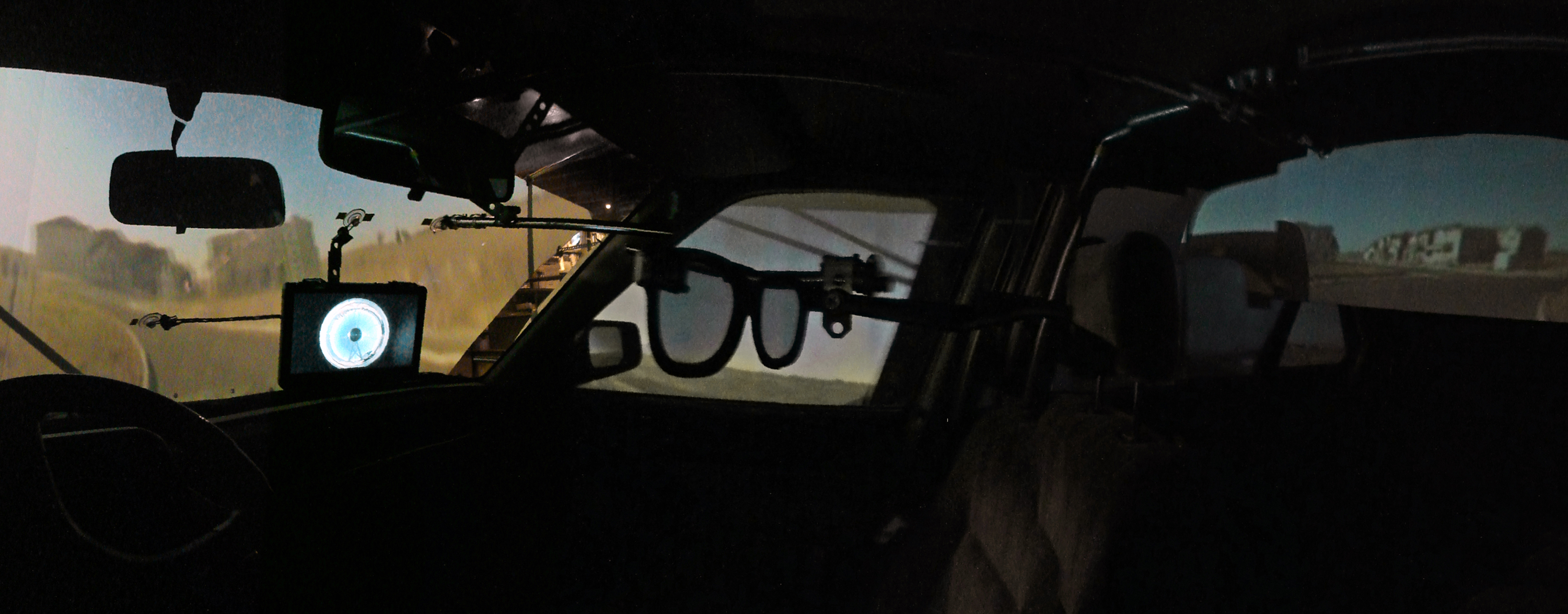ARCHITECTURAL INTERVENTION ON/IN A CAR
making-of
2011

Making-of ‘scale - scape - scope’ - Auto installation at Mackey Apartments & Garages - Los Angeles 2011
[within MAK Schindler Scholarship/Artists and Architects-in-Residence Program - MAK Museum of Applied Arts Vienna & MAK Center Los Angeles]
Concept, Realization Gregor Holzinger, Florian Schafschetzy, Eva Sommeregger Many thanks to Peter Sellars, Kimberli Meyer, Anthony Carfello, Eva Mikolasch, Fabian Holzinger
‘Architects Gregor Holzinger, Florian Schafschetzy and Eva Sommeregger have rigorously documented and simulated the traveler‘s experience of moving through the infrastructural landscapes of the American West. Driving through Utah, Nevada, Northern & Southern California, Arizona and New Mexico has allowed them to explore the unique brand of urbanism characteristic of the western United States, and its particular views about city space. The auto passenger‘s skewed and speedup experience of landscape is recreated in their installation inside the house and in the Schindler House driveway, designed to allow viewers to select their different points of focus as they „travel“ through locations like Rio Vista, a failed exuburban development where streets, sewers, and signage are all in place - but there are almost no buildings. Holzinger, Schafschetzy, and Sommeregger use this real estate anomaly and other unique features of the built environment west of the Mississippi River to engage and critique notions of Scale (how perception is altered by the freeway), Scape (the nonexistence of untouched space), and Scope (how a GPS device can alter our views as much as a kaleidoscope).‘
Exhibition / Project Documentation
[within MAK Schindler Scholarship/Artists and Architects-in-Residence Program - MAK Museum of Applied Arts Vienna & MAK Center Los Angeles]
Concept, Realization Gregor Holzinger, Florian Schafschetzy, Eva Sommeregger Many thanks to Peter Sellars, Kimberli Meyer, Anthony Carfello, Eva Mikolasch, Fabian Holzinger
‘Architects Gregor Holzinger, Florian Schafschetzy and Eva Sommeregger have rigorously documented and simulated the traveler‘s experience of moving through the infrastructural landscapes of the American West. Driving through Utah, Nevada, Northern & Southern California, Arizona and New Mexico has allowed them to explore the unique brand of urbanism characteristic of the western United States, and its particular views about city space. The auto passenger‘s skewed and speedup experience of landscape is recreated in their installation inside the house and in the Schindler House driveway, designed to allow viewers to select their different points of focus as they „travel“ through locations like Rio Vista, a failed exuburban development where streets, sewers, and signage are all in place - but there are almost no buildings. Holzinger, Schafschetzy, and Sommeregger use this real estate anomaly and other unique features of the built environment west of the Mississippi River to engage and critique notions of Scale (how perception is altered by the freeway), Scape (the nonexistence of untouched space), and Scope (how a GPS device can alter our views as much as a kaleidoscope).‘
Press release – by Anthony Carfello
Exhibition / Project Documentation
SIDE NOTES:
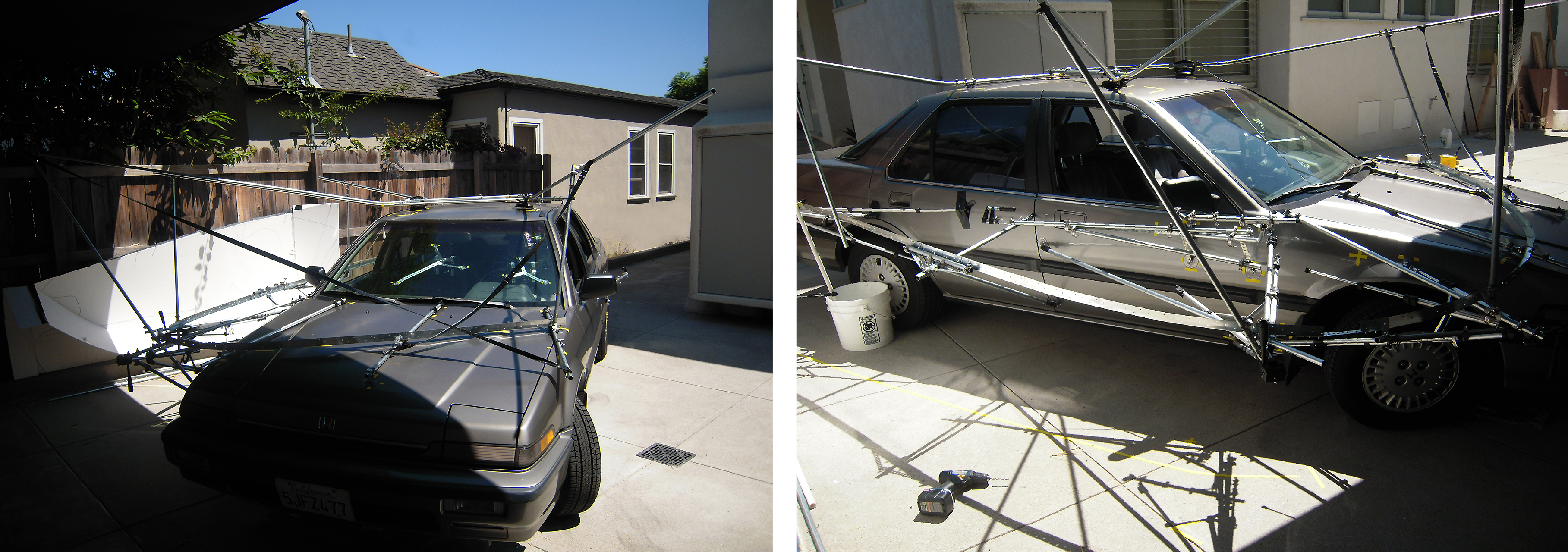
1/7
- Research road-trips (~10750 mi driven | California, Oregon, Idaho, Montana, Wyoming, Colorado, Utah, Nevada, Arizona, New Mexico) --
- (Inverse) ‘Motion Capturing‘ of landscapes (small scale, mobile inversion of a film-set, ‘on location‘ on a multi-local place: Not the car moving through the film-set, but the film-set moving through the scenery.)
- 360°-Video shoot with improvisational low-tech camera mounting system for capturing panoramic video footage out of the moving car
(compiled of ready-made parts, an adapted tri-pod and plumbing supplies, operable and retractable while driving)
 01. 09. 2011 | Week 1 -- Garage and driveway at Mackey Apartments
01. 09. 2011 | Week 1 -- Garage and driveway at Mackey Apartments2/7
- Conception and assembly of the driver´s and passenger´s side mirror projection apparatus
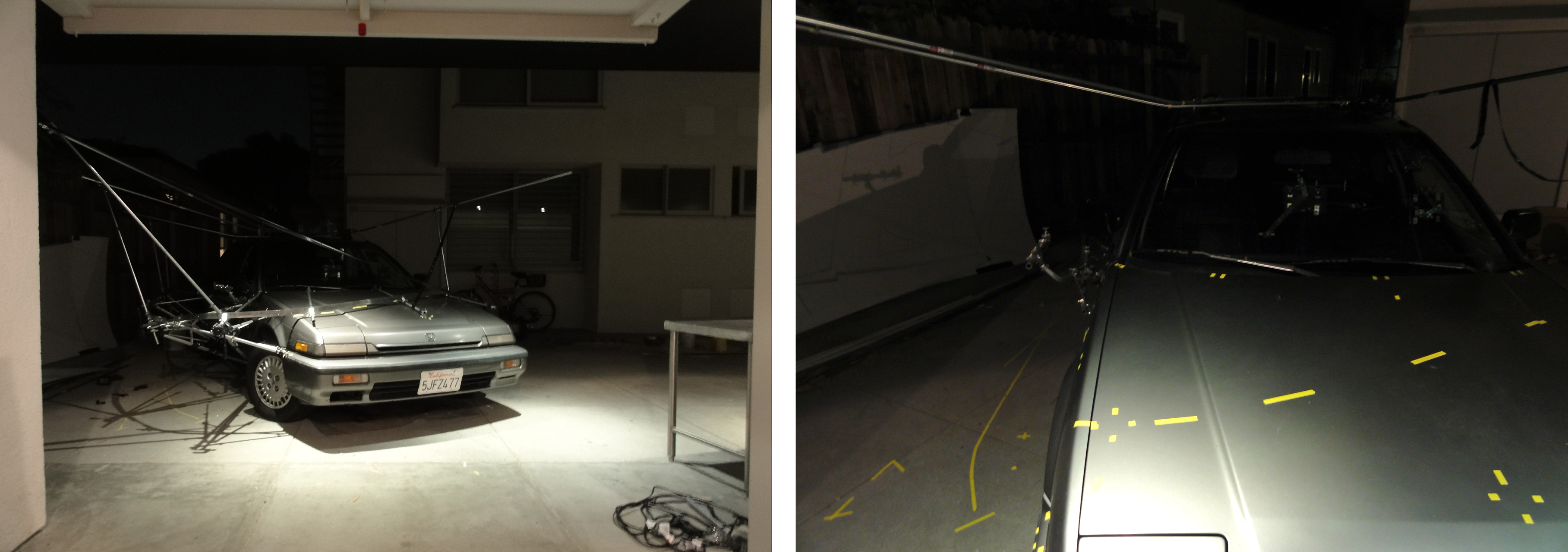
3a/7
← our Honda Accord (the site)
 1st TEST SETUP - 03. 09. 2011
1st TEST SETUP - 03. 09. 20113b/7
- Installation as its own 1:1 mock-up & working model / Installation as its own experimentation field [I] - (our Honda Accord (c. 1989) as
a ready-made - the moving, auto-mobile ‘site‘ for our site-specific installation)
- Developing geometry of 3D-projection screen (three-dimensionally curved radial screen, approximated to unwarp angular projections)
- Developed view of visual field of the driver through car windows (unrolled geometry of car windows (’Scheibenflächenabwicklung’) or sight obstructions/occlusions from the visual field caused by car chassis respectively (Analyse der Sichtabschattung aus dem Fahrzeug/Sichtverdeckungsanalyse basierend auf Nachmodellierung der Strahlengänge zur Sichtbereichsermittlung, vergl. Studien zur Automobil-Ergonomie u. a. ‘Sichtvermessung im PKW’ - Jörg Hudelmaier, TU Munich 2003)


3c/7
- Fine-tuning of side mirror projection apparatus (by means of creating a ‘light-shadow‘ on the cardboard screens)
- Making of the ‚Making-of‘
 04. 09. 2011 | Week 2
04. 09. 2011 | Week 24a/7
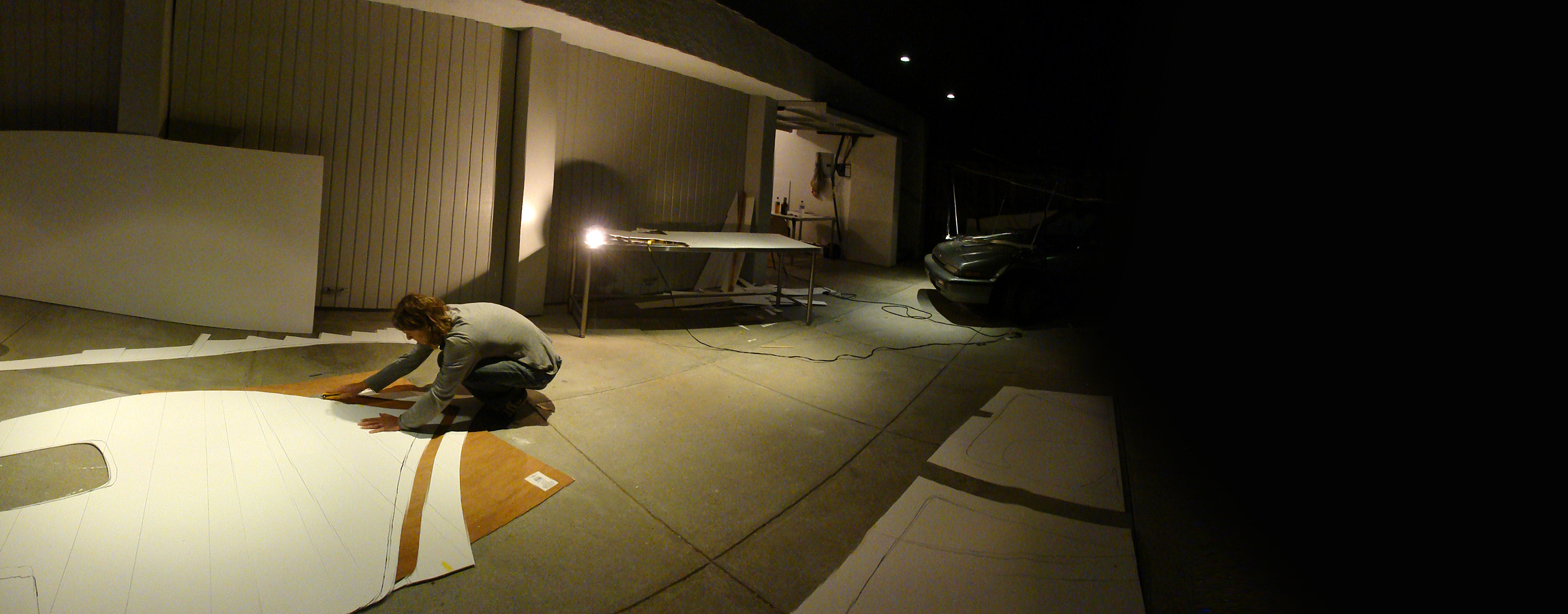
4b/7
 2nd TEST SETUP - 05. 09. 2011 -- Mackey Apartments & Driveway
2nd TEST SETUP - 05. 09. 2011 -- Mackey Apartments & Driveway5a/7
WORKING NOTES (continued):
- Analogue/Physical computing of spatial field of ‘sight-shadows‘ („Sichtschatten“ = shadows in the field of view, determined for
the eye-point of the driver by casting inverted shadows/‘light-shadows‘ (kind of) onto the panoramic backdrop)
- Installation as its own experimental setup [II] (its own generating apparatus - ‘material-computer‘) - and its own test-site
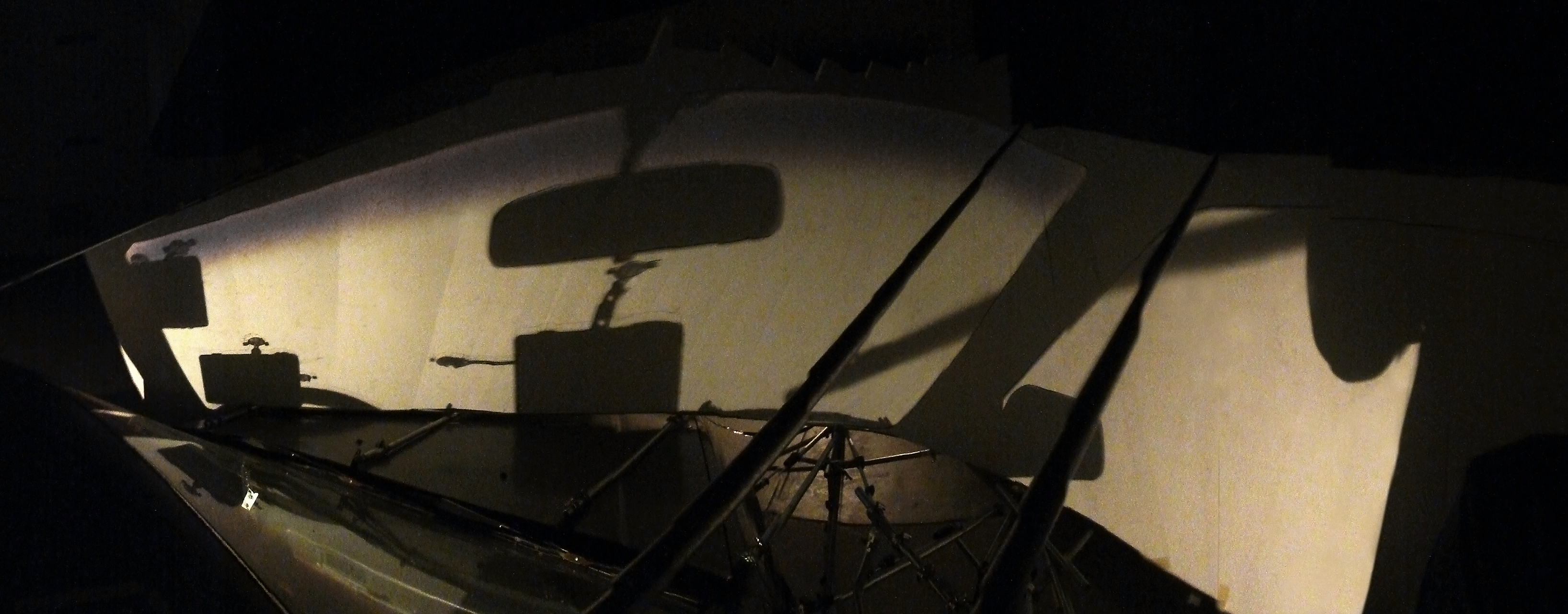
5b/7
- Driving as a cinematic experience (the car interpreted as a warped, panoramic 3-dimensional cinema) - referring to/reversing the so-called ‚process shots‘ in classic driving scenes of 1930-50s movies (‘rear-projection effect‘ - as part of many in-camera effects techniques in early film production) incorporating the distinctive washed-out look of pre-filmed or ‚borrowed‘ backgrounds
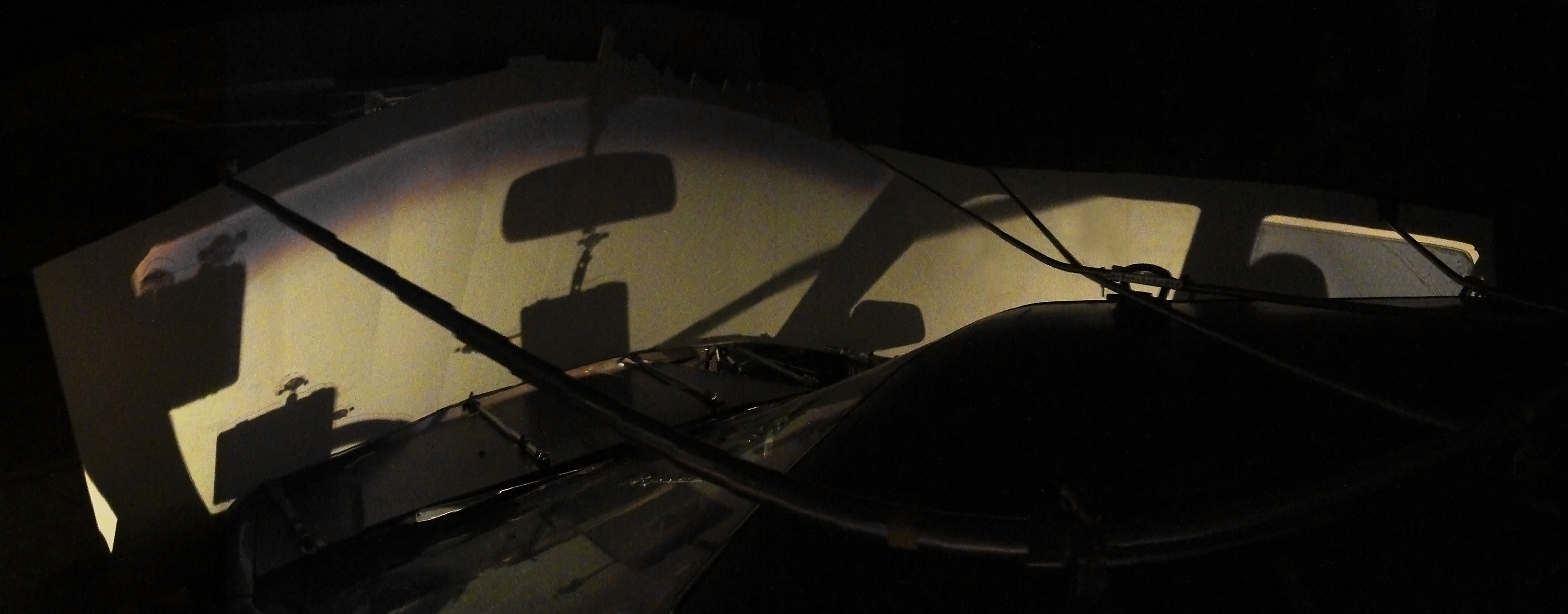
5c/7
- Car as a specific vehicle of perception, a perception apparatus or certain kind of ‚scope‘ (*.scope - cf.: for example tele-, peri- or caleidoscope -- traversing all kinds of *.scapes - masking the view of the travelers, as a highly complex framing apparatus of the passenger´s field of view)
Looking at the car as the/a vehicle of perception, it´s very strange to see how, with all its perceptional accessories, it limits views to a very special angle: The highway system for example, as a way to cover up space without the concrete need to do so, covers the land, measures through it, but it doesn´t generate a space, than rather a film in the window screens of the car, it limits perception to a very narrow stretch of transitory landscape (i.e.: the road), but 2 m next to the highway this mode of perception is rendered impossible - the landscape is perceived only along this line-type trajectory, but very rarely from another angle of view, unmasked by the car windows - and directed by the overlying road network and its desperateness to cover the space.


5d/7
- Capturing ‘sight-shadows‘ („Sichtschatten“ = shadows in the field of view) by inverting the process of shadow casting (~ ‚light-shadowing‘)
- Generation of ‚sight shadow mappings‘ or ‘sight-scapes‘ (map of sight-apertures/fragmented fields of view casted by the car windows,
highly sight-specific to driver´s viewpoint) - simulating to „cast a view“ → looking behind the shadows casted by a view
- car windows as an aperture system framing/masking the traveler´s view

- Concept of ‚embodied camera’ – „Personifizierte Kamera“→ ‚motion cartography’/ „Bewegte Kartographie“:
(motion cartography: not a cartography of movements from a superior/superordinate viewpoint (god´s eye view) – but a cartography based on an individual moving viewpoint and its panoramic perception/subjective perspective
How could - analogue to the moving camera in film - a moving cartography look like?
or:
- ‚Panoramic Cartography‘ - a cartography of moving, panoramic perspectives, an alternative geography from a roadmovie-point-of-view
- Development of a notation that is mapping the panoramic field of view of a moving viewer → capturing and representing of these perceptive patterns as a moving/motion cartography (continuous palimpsest (in real-time) of sight-specifically fleeting views)
(motion cartography: not a cartography of movements from a superior/superordinate viewpoint (god´s eye view) – but a cartography based on an individual moving viewpoint and its panoramic perception/subjective perspective
How could - analogue to the moving camera in film - a moving cartography look like?
or:
- ‚Panoramic Cartography‘ - a cartography of moving, panoramic perspectives, an alternative geography from a roadmovie-point-of-view
- Development of a notation that is mapping the panoramic field of view of a moving viewer → capturing and representing of these perceptive patterns as a moving/motion cartography (continuous palimpsest (in real-time) of sight-specifically fleeting views)
 06. 09. 2011 | Week 2
06. 09. 2011 | Week 2
6/7
- Merging of sight shadow mappings/‚view casting patterns‘ for both eyepoints (left + right) of the driver
- Developed View: Unrolling/Dewarping of car windows as a development drawing of a sweeping view = “Scheibenabwicklungsflächen“ (+rewarping into spatial backdrop projection screen, centered onto the driver´s spherical visual field


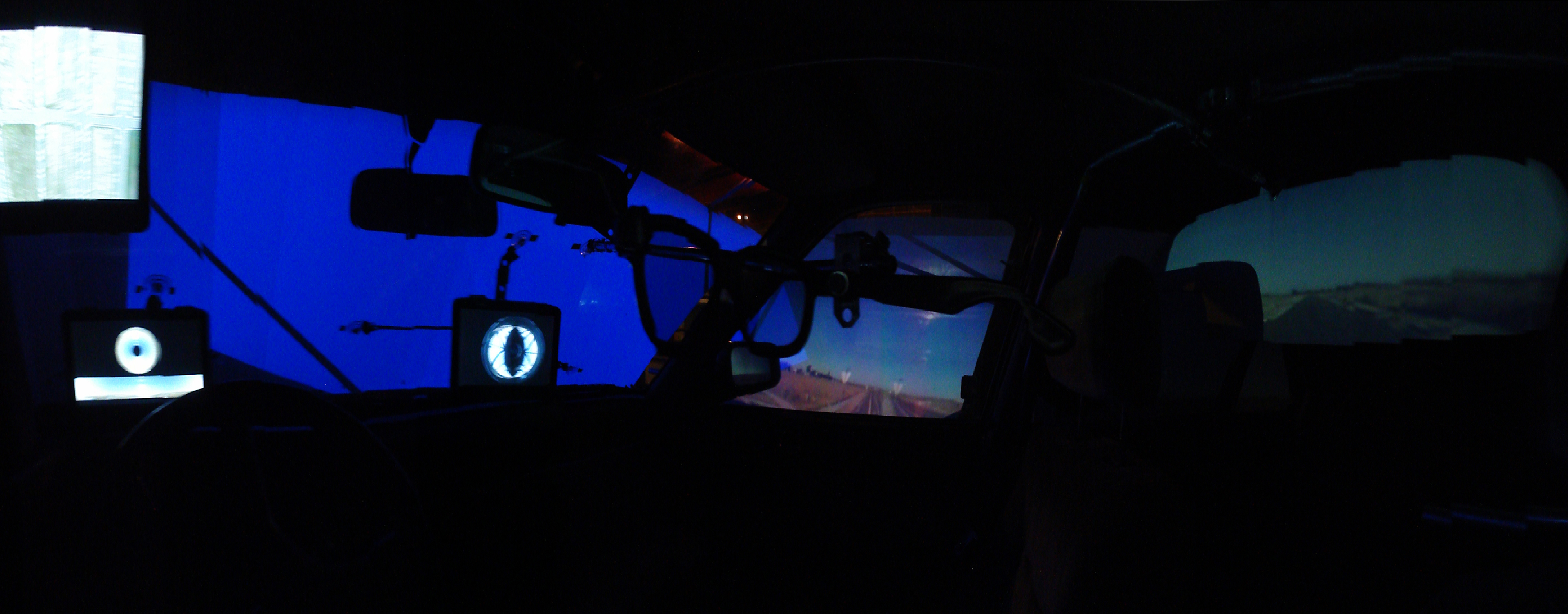
TECH REHEARSAL - 08. 09. 2011 | 5 pm
7/7
- Fine-tuning of multi-angle video projection setup
- Installation as experimental setup [III] - 1st rehearsal at the opening, rehearsed and premiered at the same time
- Semi-improvised mini-theater installation / one-time performance on display/performed only for one evening, duration: ~ 2,5 hours
- Over-informed multi-angle perception apparatus, potentially located on a lot of places at the same time, moving through a multiplicity of scapes at one same time
- Dislocation of the car space not only by the process of driving, but a multiple perspectiveity as well as the ongoing palimpsest (in real-time) of spatially separated landscapes/places, superimposing/ coinciding with each other within the interior space of the car - the car space (as a → ‚heterotopic‘ space), with its potential of residing at an infinite plurality of locations, generates a quasi trans-local locality/“überörtlichen Ort“, an architecture within a changing environment, on a multi-local site, „mit wechselndem Stand- bzw. Fortbewegungsort“, which points at the contemplative appropriation of land by passing through/striding across landscapes, covering the terrain with paths
- Highway network as director of a 360°-movie shown in split-screen modus in the car windows and mirrors, a film directed by infrastructural planning/ historic traffic routing, attempted occupation/’covering of space’ and its development/ acquisition of half a continent
Exhibition / Project Documentation
[The End]
